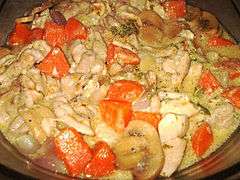Fricassee
Fricassee or fricassée /ˈfrɪkəsiː/[1] is a method of cooking meat in which it is cut up and braised, and served with its sauce (usually a white sauce but some Spanish variations are made with a base).

Fricassee of chicken is commonly found, both in modern recipes and antique ones, but virtually all kinds of meat, poultry, seafood, and even vegetables alone, can be found in fricassee dishes.
Etymology
Fricassee is first attested in England in the mid-16th century. It is a French word, but the exact etymology is uncertain. It is theorized to be a compound of the French frire (to fry) and casser or quasser (to break in pieces).[2]
History
Many cooking references describe fricassee simply as a French stew, usually with a white sauce.[3] Julia Child in Mastering the Art of French Cooking describes it as "halfway between a sauté and a stew" in that a saute has no liquid added, while a stew includes liquid from the beginning. In a fricassee, cut-up meat is first sauteed (but not browned), then liquid is added and it is simmered to finish cooking.[4] Cookbook author James Peterson notes that some modernized versions of the recipe call for the meat to be thoroughly browned before braising, but the classical version requires that both meat and vegetables remain with no caramelization.[5]
By the general description of frying and then braising in liquid, there are recipes for fricassee as far back as the earliest version of the medieval French cookbook Le Viandier, circa 1300. In 1490, it is first referred to specifically as "friquassee" in the print edition of Le Viandier.[6]
Chicken fricassee was one of Abraham Lincoln's favorite dishes.[7]
In the Spanish Caribbean, one of the more popular dishes is fricasé de pollo (chicken fricassee). It was brought to the islands by settlers from the south of France and Spain. Unlike French style fricassee, it has a tomato-based sauce usually with red wine.[8]
A 19 century recipe from California for Fricasa de pollos a la española (Spanish-style chicken fricasse) was prepared by frying chickens in lard with chopped onion, shallots, garlic and mushrooms. Tomato juice is added with olives, fresh herbs, and olive oil to make a thick stew.[9]
See also
References
- "Audio pronunciation of 'fricassee'". Merriam Webster. Archived from the original on 5 October 2011. Retrieved 10 September 2013.
- "fricassee". Online Etymology Dictionary. Retrieved 8 October 2012.
- "Fricassée". CooksInfo.com. 23 September 2010. Retrieved 7 October 2012.
- Child, Julia; Beck, Simone; Bertholle, Louisette (1969). Mastering the Art of French Cooking. Alfred A. Knopf.
- Peterson, James (2008). Sauces: Classical and Contemporary Sauce Making (3 ed.). Wiley. ISBN 978-0-470-19496-6.
- Hess, Karen (1996). Martha Washington's Booke of Cookery. Columbia University Press. p. 41. ISBN 978-0-23104-931-3.
- Rysavy, Francois (1972). A Treasury of White House Cooking. New York: Putnam. p. 250. ISBN 978-0-39910-939-3.
- "pollofricase". El Boricua. Retrieved 4 October 2016.
- El cocinero español by Encarnación Pinedo, 1898
External links
| Wikimedia Commons has media related to Fricassée. |
| Look up fricassee in Wiktionary, the free dictionary. |